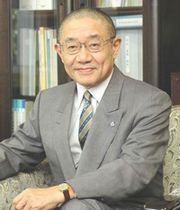|

President
of Nagasaki University
Hiroshi
Saito
M.D., Ph.D.
President's Profile
|
|
President's address
at the signing ceremony
September 13, 2005
Kenya Medical Research Institute
Your Excellency, Mr. Miyamura, Japanese Ambassador
to Kenya, Prof. Karega, Permanent Secretary of Ministry of Education, Science
and Technology, Mr. Ogongo, Permanent Secretary of Ministry of Health,
Dr. Koech, Director of Kenya Medical Research Institute, or KEMRI, distinguished
guests, ladies and gentlemen, please allow me to extend my gratitude to
you for inviting me here today.
I would also like to express my sincerest appreciation
to the people who have committed themselves to making this signing ceremony
possible.
Last November, Nagasaki University and KEMRI entered
into an Agreement of Academic Cooperation to develop notable academic and
educational collaboration as we have done so far under the JICA-KEMRI project
and other research projects.
In 2005, The Ministry of Education, Culture, Sports,
Science and Technology of Japan, or MEXT, provided the Nagasaki University
Institute of Tropical Medicine with a special budget that would promote
long-term, intensive, and extensive overseas research activities in Africa.
Since this budget is expected to be provided for
five years or more, Nagasaki University and KEMRI have agreed to launch
a new project in some area of tropical medicine.
Since January of this year, the representatives of the two research institutes have been working together to complete the MOU to facilitate and promote details of the new projects.
I am very pleased to have set my hand below to
the MOU in witness to the agreement.
Nagasaki University began the study of tropical
medicine in Africa in 1964.
Since then many Japanese researchers and doctors
have been involved in biomedical research projects and JICA projects mainly
in Kenya.
The early pioneers were the late Prof. Katamine,
a parasitologist, the late Prof. Watanabe, a pathologist, Prof. Hayashi,
a virologist, and Prof. Hara, a physician.
They strongly advocated the necessity of establishing a research base in Kenya to facilitate the research activities of tropical medicine in Japan, and made efforts to get a special budget for such an overseas research base from the former Ministry of Education, Science, Sports, and Culture, or MOE.
However, their dream melted away, because the huge
cost of the overseas operation could not be absorbed into the budget allotted
to a national university.
Whereas, in 2004, a revolutionary change occurred
in the position of national universities in Japan.
All national universities were required to adopt
an independent profit system and were given autonomy.
This major change in the management of national
universities gave Nagasaki University another chance to make a request
to MEXT for the special budget needed to facilitate research activities
in Africa.
In 2005, our dream has come true.
I am sure that the many Japanese and Kenyans who
have been involved in research and technical cooperation in Kenya, are
very pleased to know that the new research-oriented KEMRI-Nagasaki University
project has started today.
I believe our cooperation in the control of infectious
diseases will contribute greatly to the welfare and health of mankind.
Thank you very much.
(MOU Signing Ceremony between Kenya Medical Research Institute and Nagasaki
University Institute of Tropical Medicine
September 13, 2005 in Nairobi, Kenya) |